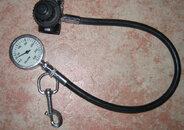geraldp
Contributor
For my first 40 or so dives I had a ScubaPro mini SPG & depth guage in a console to back up my Cobra, but abandoned it in an attempt to get myself more streamlined. Besides I reasoned that unless I also had a Bottom Timer and a copy of the tables (or memorized them) they wouldn't give me that much of an advantage. So now my back up is my buddyI use a Cressi mini spg/depth gauge console as a backup, just because I don't want to be at 100 ft without this vital information in the event of a transmitter or computer failure.





